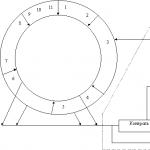Presentation on chemistry - chemistry and everyday human life. Presentation on the topic “chemistry and everyday human life” Using Coca-Cola in everyday life
Introduction Everywhere we are surrounded by objects and products made from substances and materials obtained in chemical plants and factories. Besides, in Everyday life Without knowing it, every person carries out chemical reactions. For example, washing with soap, washing with detergents etc. By lighting a match, mixing sand and cement with water, burning a brick, we carry out real and sometimes quite complex chemical reactions. Cooking is also a chemical process. It is only necessary to note that in any living organism various chemical reactions take place in huge quantities. The processes of assimilation of food, breathing of animals and humans are based on chemical reactions.
Home first aid kit Hydrogen peroxide (H 2 O 2) is an excellent antiseptic. Ammonia (an aqueous solution of ammonia NH 3) stimulates the respiratory center. Aspirin, or acetylsalicylic acid, is one of the drugs that is widely used as an antipyretic, anti-inflammatory, analgesic and antirheumatic agent. Medicines for the treatment of the cardiovascular system are validol, corvalol, nitro glycerin. Means for the treatment of the digestive system. Antibiotics. Vitamins are a means of strengthening the body, increasing overall tone, and resisting diseases Medications- potent drugs.

Matches and lighters In a lighter, the fuel is ignited by a spark resulting from the combustion of a tiny particle of “flint” cut off by a toothed wheel. There are several varieties of modern matches. According to their intended purpose, they distinguish between matches that light under normal conditions, moisture-resistant (designed to ignite after storage in humid conditions, for example in the tropics), wind matches (lighted in the wind), etc.

Pencils To make the working part of a graphite pencil, prepare a mixture of graphite and clay with the addition of a small amount of hydrogenated sunflower oil. Depending on the ratio of graphite and clay, a lead of varying softness is obtained; the more graphite, the softer the lead. Colored pencil leads contain kaolin, talc, stearin and calcium stearate (calcium soap).

Glass In glassmaking, only the purest varieties of quartz sand are used, in which the total amount of impurities does not exceed 23%. The glass composition includes the oxides SiO 2, Na 2 O and CaO, and also contains a little alumina A l 2 O 3. Boric acid oxide B 2 O 3 makes glass more resistant to sudden temperature changes. Glass is colored by introducing oxides of certain metals into it or by forming colloidal particles of certain elements.

Crystal This is a silicate glass containing varying amounts of lead oxide. Product labeling often indicates lead content. The greater the quantity, the higher the quality of the crystal. Crystal is characterized by high transparency, good shine and high density.

Foam glass Foam glass is a porous material, which is a glass mass permeated with numerous voids. It has heat and sound insulation properties, low density and high strength comparable to concrete. Foam glass is an extremely effective material for filling the internal and external walls of buildings.

Soaps Soaps French chemist Chevreul discovered stearic, palmitic and oleic acid, as products of decomposition of fats when they are saponified with water and alkalis. The sweet substance was named glycerin by Chevreul. Rosin has been used in soap production for a long time. The introduction of rosin in large quantities makes the soap soft and sticky. In addition to using soap as a detergent, it is widely used in finishing fabrics, in the production of cosmetics, for the manufacture of polishing compounds and water-based paints.

Cleaning agents When cleaning agents act on the surface layer of a material, a complex complex of physical and chemical processes, including wetting, dispersing and sorption of contaminant particles, preventing their back deposition onto the treated surface. Cleaning products are used in the form of powders, liquids, pastes, suspensions, and emulsions. The composition of powdered preparations may include surfactants, sodium metasilicate and tripolyphosphate, Na 2 CO 3, fragrances, glycerin and ethylene glycol, sodium tripolyphosphate, Na 2 CO 3, surfactant disinfectants, urea, organic solvents, etc.

Chemical hygiene products and cosmetics Chemical hygiene products and cosmetics Cosmetics and hygiene are closely related, since there are cosmetics (lotion, creams, shampoos, gels) that perform a hygienic function. Important hygiene products include, first of all, soaps and detergents.

Dental care products The most important means dental care products are toothpastes. The main components of toothpaste: abrasives, binders, foaming agents and thickeners. The first of them provide mechanical cleaning of teeth from plaque and polishing. Most often, chemically precipitated calcium carbonate is used as an abrasive, as well as calcium phosphates and polymeric sodium metaphosphate.

Deodorants Deodorants are produced in solid form, roll-on and in aerosol packaging. Aerosol cans use liquefied gases whose boiling point is very low. They easily pass into the gas phase and not only push the base out of the container, but, expanding, spray it into small droplets. For a long time, only chlorofluorocarbons performed this role.

Cosmetical tools The pearlescent effect in cosmetics is created by bismuthyl salts B iO C l and BiO (NO3) or titanated mica pearlescent powder containing about 40% T iO2. To create special cosmetics (make-up), zinc oxide ZnO is used. In medicine, it is used in powders and for making ointments. Dilute aqueous solutions of highly soluble salts of lead, silver, copper, and bismuth are used as hair dyes. Hair lightening is done using a 3% hydrogen peroxide solution. Coloring shampoos contain p-phenylenediamine, resorcinol and other similar compounds.

Candle and light bulb Candles consist of a mixture of paraffin and ceresin. The light bulb consists of a glass container into which the spiral holders are inserted, and the spiral itself. The spiral is made of tungsten, one of the most refractory metals. The holder is made of molybdenum. When heated, it changes dimensions synchronously, just like glass, the latter does not crack and therefore the seal is not broken.


Fats Fats make up an essential part of our food. They are found in meat, fish, dairy products, and grains. Components of natural fat, important of which are phosphatides, sterols, vitamins, pigments and odor carriers. Phosphatides are actually also esters, but they contain residues of phosphoric acid and amino alcohol. Sterols are natural polycyclic compounds of very complex configuration. A representative is cholesterol. Vitamins. They are rich in the liver of fish and sea animals, vegetable fats, and butter. Pigments are substances that give color to fats. Odor carriers are very diverse and complex in structure; there are more than 20 of them in butter.

Carbohydrates Carbohydrates are the main providers of energy to the human body. We get carbohydrates from grains, legumes, potatoes, fruits and vegetables. Glucose is a monosaccharide (C 6 H 12 O 6). Glucose is easily absorbed by the body. Glucose is found in fruits and berries. Fructose (C 6 H 12 O 6) is also a monosaccharide, an isomer of glucose. Sucrose is a disaccharide (C 12 H 22 O 11). In everyday life it's just sugar. Lactose is a disaccharide (C 12 H 22 O 11) Mainly found in animal milk. Starch is a polysaccharide ((C 6 H 10 O 5) n) - the main carbohydrate of food. Found in potatoes and grains. Glycogen (“animal starch”) Cellulose ((C 6 H 10 O 5) n) is a plant polysaccharide. Enters the body with plant foods.

Proteins Proteins are natural high-molecular compounds, the structural basis of which is made up of polypeptide chains built from alpha amino acid residues. Proteins are the basis of all life on Earth and perform diverse functions in organisms. Proteins that enter the body with animal and plant foods are ultimately hydrolyzed to alpha amino acids. Hydrolysis of proteins and the synthesis of new ones from hydrolysis products can reduce the risk of protein deficiency; the body itself creates what it needs.


Development Food Industry Doctors recommend including bread made from flour containing finely ground bran in the menu for a balanced and dietary diet. Nowadays we often talk about artificial food. Although this term does not mean obtaining food through chemical reactions. It's about about giving natural protein products the taste and appearance of traditional products, including delicacies. Food additives help preserve the product, give it flavor, the desired color, etc.

Food additives Food additives E 100- E 182- dyes E 200- E 299- preservatives E 300- E 399- substances that slow down the processes of fermentation and oxidation in food products E 400- E 409- stabilizers (ensure long-term preservation of consistency) E 500 - E 599 - emulsifiers E 600 - E 699 - flavorings (enhance or add taste to food products) E 900 - E 999 - anti-flaming agents that do not allow flour to cake, granulated sugar, salts, soda, citric acid, baking powder, as well as substances that prevent the formation of foam in drinks.

Conclusion Chemistry, having enormous potential, creates unprecedented materials, increases soil fertility, facilitates a person’s work, saves his time, clothes him, preserves his health, creates coziness and comfort for him, and changes the appearance of people. But the same chemistry can also become dangerous to human health, even deadly.

Chemistry in everyday human life Nika Bulanova 11 “A” class MBOU Secondary School No. 30, Podolsk
Chemistry and everyday human life Chemistry, having enormous potential, creates unprecedented materials, increases soil fertility, facilitates a person’s work, saves his time, clothes him, preserves his health, creates coziness and comfort for him, and changes the appearance of people. But the same chemistry can also become dangerous to human health, even deadly.
Home first aid kit Hydrogen peroxide is an excellent antiseptic. Ammonia and an aqueous solution of ammonia stimulates the respiratory center. Aspirin, or acetylsalicylic acid, is one of the drugs that is widely used as an antipyretic, anti-inflammatory, analgesic and antirheumatic agent. Medicines for the treatment of the cardiovascular system are validol, corvalol, nitro glycerin.
Detergents and detergents Currently, synthetic detergents are widely used. The main one is synthetic surfactants, in which a long hydrocarbon limiting radical is connected to a sulfate or sulfonate group. In addition to surfactants, SMS also includes other components: bleach, softener, foaming agents, aromatic fragrances. The most common oxygen-containing bleaches are sodium perborate and sodium percarbonate.
Means for fighting household insects Insecticides are means for fighting insects. Insecticides are used in the form of solutions, emulsions, and aerosols. Residential premises should be treated only with preparations recommended for this purpose. These are well-known drugs: chlorophos (), dichlorvos, chlorophos pencils.
Chemical hygiene products and cosmetics Cosmetics and hygiene are closely related, since there are cosmetics (lotion, creams, shampoos, gels) that perform a hygienic function. Important hygiene products include, first of all, soaps and detergents.
Dental care products The most important dental care products are toothpastes. The main components of toothpaste are as follows: abrasives, binders, foaming agents and thickeners. The first of them provide mechanical cleaning of teeth from plaque and polishing. Most often, chemically precipitated calcium carbonate is used as an abrasive, as well as calcium phosphates and polymeric sodium metaphosphate.
Deodorants Deodorants are produced in solid form, roll-on and in aerosol packaging. Aerosol cans use liquefied gases whose boiling point is very low. They easily pass into the gas phase and not only push the base out of the container, but, expanding, spray it into small droplets. For a long time, only chlorofluorocarbons performed this role.
Cosmetics The pearlescent effect is created by bismuthyl salts or mica containing about 40% titanium oxide. Dilute aqueous solutions of highly soluble salts of lead, silver, copper, and bismuth are used as hair dyes. Hair lightening is done using a 3% hydrogen peroxide solution. Coloring shampoos contain p-phenylenediamine, resorcinol and other similar compounds.
Chemistry and food Man is the only creature on Earth who subjects almost all of his food to chemical or heat treatment.
Development of the food industry For rational and dietary nutrition, doctors recommend including bread made from flour containing finely ground bran in the menu. Nowadays people often talk about “artificial food”. Although this term does not mean obtaining food through chemical reactions. We are talking about giving natural protein products the taste and appearance of traditional products, including delicacies.
Chemistry surrounds us everywhere, but unfortunately it does not always have a beneficial effect on humans.
Slide 1
Slide 2

Slide 3
 Every day we perform seemingly ordinary actions: salting food, writing on a blackboard with chalk, boiling water. But in reality, we perform chemical actions with various chemicals!
Every day we perform seemingly ordinary actions: salting food, writing on a blackboard with chalk, boiling water. But in reality, we perform chemical actions with various chemicals!
Slide 4
 Salt- Sodium chloride NaCl is not without reason an important component of food. This substance, in a dissolved state, is part of the blood and intercellular fluid. In case of severe bleeding, the volume of circulating blood is replenished with the so-called isotonic solution - 0.9% sodium chloride solution.
Salt- Sodium chloride NaCl is not without reason an important component of food. This substance, in a dissolved state, is part of the blood and intercellular fluid. In case of severe bleeding, the volume of circulating blood is replenished with the so-called isotonic solution - 0.9% sodium chloride solution.
Slide 5
 The well-known potassium permanganate (potassium permanganate KMnO4) is one of these “mysterious natures”. For those who are getting acquainted with this substance for the first time, it presents many surprises: Potassium permanganate in solid form is black-violet crystals that are highly soluble in water. In medicine, aqueous solutions of potassium permanganate of various concentrations are used. For rinsing and washing the stomach in case of poisoning - 0.01-0.1% solutions of pale pink color, for washing wounds - 0.1-0.5% (pink), For treating ulcers and burns - 2- 5% - e (purple). Solutions of potassium permanganate are used to treat burns. Potassium permanganate will also help with a snake bite.
The well-known potassium permanganate (potassium permanganate KMnO4) is one of these “mysterious natures”. For those who are getting acquainted with this substance for the first time, it presents many surprises: Potassium permanganate in solid form is black-violet crystals that are highly soluble in water. In medicine, aqueous solutions of potassium permanganate of various concentrations are used. For rinsing and washing the stomach in case of poisoning - 0.01-0.1% solutions of pale pink color, for washing wounds - 0.1-0.5% (pink), For treating ulcers and burns - 2- 5% - e (purple). Solutions of potassium permanganate are used to treat burns. Potassium permanganate will also help with a snake bite.
Slide 6
 Iodine. The name of the new element was assigned in 1813 by the French chemist Joseph - Louis Gay-Lussac (1778-1850) for the violet color of its vapors (“iodos” means “purple” in Greek). Sodium iodide from algae, interacting with sulfuric acid, releases iodine (I); at the same time, sulfur dioxide is formed - sulfur dioxide SO2: 2NaI + 2H2SO4 = I2 + SO2+ Na2SO4 + 2H2O For a long time, iodine did not find use in medicine. Only in 1904, the Russian military doctor Filonchikov introduced 5-10% alcohol into practice. iodine solutions for treating wounds.
Iodine. The name of the new element was assigned in 1813 by the French chemist Joseph - Louis Gay-Lussac (1778-1850) for the violet color of its vapors (“iodos” means “purple” in Greek). Sodium iodide from algae, interacting with sulfuric acid, releases iodine (I); at the same time, sulfur dioxide is formed - sulfur dioxide SO2: 2NaI + 2H2SO4 = I2 + SO2+ Na2SO4 + 2H2O For a long time, iodine did not find use in medicine. Only in 1904, the Russian military doctor Filonchikov introduced 5-10% alcohol into practice. iodine solutions for treating wounds.
Slide 7
 Baking soda. For the first time this compound of the composition NaHCO3 (sodium bicarbonate) was obtained in its pure form by the French scientist Henri-Louis Duhamel de Monceau (1700-1781). Later chemists different countries received this substance by passing carbon dioxide through an aqueous solution of soda - sodium carbonate. Alkaline solutions of baking soda soften living tissues, so rinsing the throat and mouth with soda helps mechanically remove the infection. It is even better to use soda - saline solutions with iodine added. Soda baths (1 tablespoon of baking soda per 1 liter of warm water) are good for softening calluses on the hands and feet. They can be done 2-3 times a week. Dry baking soda is used to treat fresh burns.
Baking soda. For the first time this compound of the composition NaHCO3 (sodium bicarbonate) was obtained in its pure form by the French scientist Henri-Louis Duhamel de Monceau (1700-1781). Later chemists different countries received this substance by passing carbon dioxide through an aqueous solution of soda - sodium carbonate. Alkaline solutions of baking soda soften living tissues, so rinsing the throat and mouth with soda helps mechanically remove the infection. It is even better to use soda - saline solutions with iodine added. Soda baths (1 tablespoon of baking soda per 1 liter of warm water) are good for softening calluses on the hands and feet. They can be done 2-3 times a week. Dry baking soda is used to treat fresh burns.
Slide 8
 Ammonia is an aqueous solution of ammonia. The name "ammonia" comes from the name of the Ammon oasis and was assigned to this substance after 1787. Ammonia released from ammonia causes stimulation of the respiratory centers. However a large number of ammonia may cause respiratory arrest. Ammonia is used as a first aid remedy to bring a person out of fainting.
Ammonia is an aqueous solution of ammonia. The name "ammonia" comes from the name of the Ammon oasis and was assigned to this substance after 1787. Ammonia released from ammonia causes stimulation of the respiratory centers. However a large number of ammonia may cause respiratory arrest. Ammonia is used as a first aid remedy to bring a person out of fainting.
Slide 9
 Every person has all these substances in their first aid kit. Chemical compounds are also present in the body of each of us, and they play a huge role in human life and health.
Every person has all these substances in their first aid kit. Chemical compounds are also present in the body of each of us, and they play a huge role in human life and health.
Slide 10
 Proteins In metabolic processes between external environment and the leading place in the body is occupied by protein metabolism. Proteins enter the human and animal body with various food products, in which the protein content varies widely. Protein molecules have big sizes, which is why they are called macromolecules. In addition to carbon, oxygen, hydrogen and nitrogen, proteins can contain sulfur, phosphorus and iron. Proteins differ from each other in the number, composition and sequence of monomers. The monomers of proteins are amino acids.
Proteins In metabolic processes between external environment and the leading place in the body is occupied by protein metabolism. Proteins enter the human and animal body with various food products, in which the protein content varies widely. Protein molecules have big sizes, which is why they are called macromolecules. In addition to carbon, oxygen, hydrogen and nitrogen, proteins can contain sulfur, phosphorus and iron. Proteins differ from each other in the number, composition and sequence of monomers. The monomers of proteins are amino acids.
Slide 11
 Carbohydrates Carbohydrates (sugars) are one of the most important and widespread groups of natural organic compounds. They make up 80% of the dry matter mass of plants and about 2% of the dry matter of animal organisms. Animals and humans are not able to synthesize sugars and obtain them from various food products of plant origin. In plants, carbohydrates are formed from carbon dioxide and water during the complex reaction of photosynthesis carried out by solar energy with the participation of the green pigment of plants - chlorophyll.
Carbohydrates Carbohydrates (sugars) are one of the most important and widespread groups of natural organic compounds. They make up 80% of the dry matter mass of plants and about 2% of the dry matter of animal organisms. Animals and humans are not able to synthesize sugars and obtain them from various food products of plant origin. In plants, carbohydrates are formed from carbon dioxide and water during the complex reaction of photosynthesis carried out by solar energy with the participation of the green pigment of plants - chlorophyll.
Slide 12
 Fats Fats make up an essential part of our food. They are found in meat, fish, dairy products, and grains. Any natural fat contains: phosphatides, sterols, vitamins, pigments and odor carriers. Usually, only a small part of the fat is stored in reserve, but due to an incorrect lifestyle, the balance between the intake of substances and their expenditure is disrupted, which leads to obesity.
Fats Fats make up an essential part of our food. They are found in meat, fish, dairy products, and grains. Any natural fat contains: phosphatides, sterols, vitamins, pigments and odor carriers. Usually, only a small part of the fat is stored in reserve, but due to an incorrect lifestyle, the balance between the intake of substances and their expenditure is disrupted, which leads to obesity.
Chemistry presentation - Chemistry and everyday human life
Chemistry, possessing enormous capabilities, creates unprecedented materials, increases soil fertility, facilitates a person’s work, saves his time, clothes him, preserves his health, creates coziness and comfort for him, changes the appearance of people. But the same chemistry can also become dangerous to human health, even deadly.
Home first aid kit
Hydrogen peroxide is an excellent antiseptic.
Ammonia and an aqueous solution of ammonia stimulates the respiratory center.
Aspirin, or acetylsalicylic acid, is one of the drugs that is widely used as an antipyretic, anti-inflammatory, analgesic and antirheumatic agent.
Medicines for the treatment of the cardiovascular system are validol, corvalol, nitro glycerin.
Detergents and cleaning products
Currently, synthetic detergents are widely used. The main one is synthetic surfactants, in which a long hydrocarbon limiting radical is connected to a sulfate or sulfonate group. In addition to surfactants, SMS also includes other components: bleach, softener, foaming agents, aromatic fragrances.
The most common oxygen-containing bleaches are sodium perborate and sodium percarbonate.
Products for controlling household insects
Insecticides are means for controlling insects. Insecticides are used in the form of solutions, emulsions, and aerosols. Residential premises should be treated only with preparations recommended for this purpose. These are well-known drugs: chlorophos (), dichlorvos, chlorophos pencils.
Chemical hygiene and cosmetic products
Cosmetics and hygiene are closely related, since there are cosmetics (lotion, creams, shampoos, gels) that perform a hygienic function. Important hygiene products include, first of all, soaps and detergents.
Dental care products
The most important means of dental care are toothpastes. The main components of toothpaste are as follows: abrasives, binders, foaming agents and thickeners. The first of them provide mechanical cleaning of teeth from plaque and polishing. Most often, chemically precipitated calcium carbonate is used as an abrasive, as well as calcium phosphates and polymer sodium metaphosphate
Deodorants
Deodorants are produced in solid form, roll-on and in aerosol packaging. Aerosol cans use liquefied gases whose boiling point is very low. They easily pass into the gas phase and not only push the base out of the container, but, expanding, spray it into small droplets. For a long time, only chlorofluorocarbons performed this role.
Cosmetical tools
The pearlescent effect is created by bismuthyl salts or mica containing about 40% titanium oxide.
Dilute aqueous solutions of highly soluble salts of lead, silver, copper, and bismuth are used as hair dyes.
Hair lightening is done using a 3% hydrogen peroxide solution.
Coloring shampoos contain p-phenylenediamine, resorcinol and other similar compounds.
Chemistry and food
Man is the only creature on Earth who chemically or thermally treats almost all of his food.
Download Chemistry Presentation - Chemistry and everyday human life
Publication date: 10/31/2010 04:17 UTC
Tags: :: :: :: :: :.
“Chemistry spreads its hands wide into human affairs...” M.V. Lomonosov Completed by: Zharinov Alexander Vladimirovich Pupil 8 “B” of class MBOU gymnasium No. 1 urban settlement. Rybnaya Sloboda RT If there were no chemistry, there would be no modern metallurgy, spaceships would not have escaped into space, because fuel for their engines, durable and heat-resistant materials for their structures are created using chemistry. Chemistry has enormous potential:: increases soil fertility, clothes, creates unprecedented materials, as well as coziness and comfort, preserves health, changes the appearance of people, facilitates human work The importance of chemistry Pharmaceutical industry Construction Metallurgy Production of detergents Means for combating household insects Cosmetics Agriculture Pharmaceuticals Chemistry plays a major role in the development of the pharmaceutical industry: the bulk of all drugs are obtained synthetically. Thanks to chemistry, many revolutions in medicine have been accomplished. Without chemistry, we would not have painkillers, sleeping pills, antibiotics or vitamins. This undoubtedly does chemistry credit. Chemistry also helped to cope with unsanitary conditions. Construction It is difficult to imagine the modern development of construction without the use of chemical industry products: the use and introduction of new structural polymer materials, plastics, synthetic fibers, rubbers, binders and finishing substances and many other useful products of large and small chemicals. Metallurgy The development of chemistry began long before the beginning of our era. Its most ancient direction is metallurgy. It was then that people began to study the transformations of various substances under various conditions and began to use chemistry for their needs. First, they learned how to obtain metals (primarily copper) and mix it with tin to obtain bronze. Later iron was also obtained from ore. Production of detergents Currently, synthetic detergents and detergents are widely used. The main one is synthetic surfactants. In addition to surfactants, SMS also includes other components: bleach, softener, foaming agents, aromatic fragrances. Means for fighting household insects Insecticides are means for fighting insects. Insecticides are used in the form of solutions, emulsions, and aerosols. Residential premises should be treated only with preparations recommended for this purpose. These are well-known drugs: chlorophos, dichlorvos, chlorophos pencils. Cosmetics The pearlescent effect is created by bismuthyl salts or mica containing about 40% titanium oxide. agriculture, which uses mineral fertilizers, plant protection products against pests, plant growth regulators, chemical additives and preservatives for animal feed and other products. The use of chemical methods in agriculture has led to the emergence of a number of related sciences, for example, agrochemistry and biotechnology, the achievements of which are now widely used in agricultural production. The harm of chemistry in human life But the same chemistry can also become dangerous to human health, even deadly. Have you ever thought about how much natural water becomes unsuitable for drinking and the living organisms inhabiting it due to industrial and domestic wastewater being discharged into water bodies! . Unrecycled household waste pollutes natural landscapes, turning river banks and meadows into disgusting garbage dumps. Therefore, the achievements of chemistry are not only a blessing, they are also chemical weapons, environmental pollution, ozone holes, and an increased content of nitrates and nitrites in food, and a number of others problems. People who use the achievements of chemistry to harm themselves and our common home, planet Earth, are to blame for these troubles. It is clear, therefore, how important it is for a modern person to know and correctly use the achievements of modern chemistry. There are many wonderful forces in nature, but






